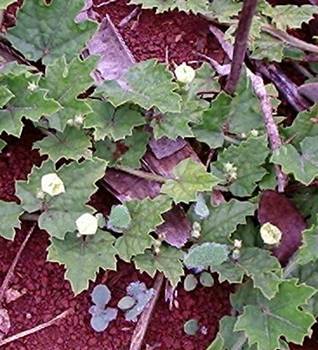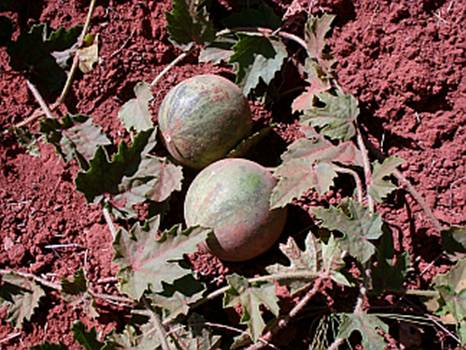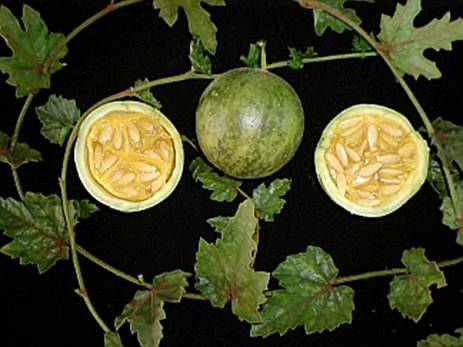MELANCIUM CAMPESTRE
FAMILY OF CUCURBITACEAE
|
|
|
|
|
FLOWERS |
MATURE FRUITS |
MATURE FRUITS AND PULP |
NOMENCLATURE AND SIGNIFICANCE: Cabacuí or Caboi-curai comes from the Tupi-Guarani and means “Hanging erva and hairy powder or sour fruit”, the qualities are obvious with the view of the Indians. Also called as cabacinha do campo, melancia do cerrado or melancia do campo.
Origin:
Occurs in
clean and dirty steppes
or in
open savannas in the
states of Goiás, Minas
Gerais, São
Paulo and a small
part
of Paraná
and Mato Grosso do
Sul in Brazil
with less
frequency. More
informations in the Portuguese language under the link:
Features: The plant is living for two years and has creeping shoots that are 2-5 feet long. The shoots are covered with soft bristles, the leaf is heart-shaped with a rough and brittle texture of the leaf margin with rounded cutouts or beginning with 3 central ribs are clearly visible. The flowers are small and yellow-cream, appear at the top of the leaves. The berries are with thick skins and contain about 90 foil wrapped seeds in yellow gelatinous pulp, the taste is semisour, are 4-5 cm long and weigh 100 to 180 grams.
Culture tips: The plant is easily propagated by seeds, which are planted in holes previously, an acidic soil does not need to be corrected, because the poor soils preferred plant is resistant to drought and light frosts to -3°C. The plant produces only in full sun fruits and seeds that need to be re-sown every year, since the plant is not perennial. In some frost-free regions of the plant can grow and develop roots and bear fruit for another year.
Propagation: The small seeds are very similar to the ordinary melon. The seeds are orthodox (enter dormancy) and can be stored for up to three years if they are well cleaned and dried and stored in dark containers. In situ 4 seeds should be sown directly. Germination begins after 25 days and extends to 65 days. The plant begins production 6 months to 9 months after sowing.
Planting: I recommend planting in full sun at a distance of 3 x 3 m. The best planting time is from August to October, pouring after planting with 10 liters of water every 15 days if it is not raining. The planting holes should not measure 40 cm in 3 dimensions, should be prepared by filled with 20 cm of soil, 3 shouvels of the organic matter and 2 shouvels, if sandy loam (if the soil contains no sand) to give 20 grams of NPK 4-14-8 and mix well.
Culture: The plant grows slowly and requires no special treatment, should only be mulched and weed weeded regularly, so that the plant is not stifled. It is not necessary to fertilize. Pour every 15 days during the dry season
Use: Bears fruit in the months from July to September. The fruits can be eaten raw, although they are tart, or can be used in the form of jellies and juices. The plant should not be missing in revegetation projects in the savannah and the surrounding grassland, because wild animals eat their fruit in times of food scarcity.
ERFAHREN SIE MEHR ÜBER DIE KLASSIFIZIERUNG, HERKUNFT, GESCHICHTE, BESCH
BUY THE BOOK “COLECIONANDO FRUTAS”
Back to the seedlist (English) or back to Cucurbitaceae (Portuguese)


